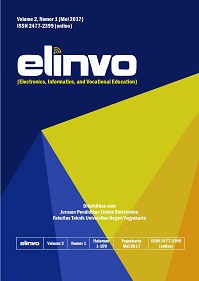Implementation of K-Means Clustering in Mapping Teacher Distribution Using Geographic Information System
DOI:
https://doi.org/10.21831/elinvo.v9i1.76884Keywords:
Teachers' distribution, clustering, K-Means, GIS, QGISAbstract
References
M. Novita, C. Wijaya, and A. Atmoko, "Dynamic of Indonesian Teacher Distribution Policies Implementation at Regional Level," Journal of Education & Social Policy, vol. 7, no. 1, pp. 15–24, 2020.
J. Zhang, S. Jin, M. Torero, and T. Li, "Teachers and Urban"Rural Gaps in Educational Outcomes," American Journal of Agricultural Economics, vol. 100, no. 4, pp. 1207–1223, 2018.
E. Purwanto and Y. Hayati, "Impact of teacher distribution on student academic performance in rural Indonesia," J. Educ. Dev., vol. 6, no. 2, pp. 100–110, 2018.
Drake, B. C. (1997). Geographic Dimensions of Indonesia's Increasing Importance in the World. 19–26.
Mustakim, Z., & Kamal, R. (2021). K-Means Clustering for Classifying the Quality Management of Secondary Education in Indonesia. Cakrawala Pendidikan, 40(3), 725–737. https://doi.org/10.21831/cp.v40i3.40150.
T. Widiyaningtyas, U. Pujianto, and M. Prabowo, "K-Medoids and K-Means Clustering in High School Teacher Distribution," 2019 Int. Conf. Electr. Electron. Inf. Eng. (ICEEIE), pp. 330–335, 2019, doi: 10.1109/ICEEIE47180.2019.8981466.
Chen, Y., Tan, P., Li, M., Yin, H., & Tang, R. (2024). K-means clustering method based on nearest-neighbor density matrix for customer electricity behavior analysis. International Journal of Electrical Power and Energy Systems, 161(July). https://doi.org/10.1016/j.ijepes.2024.110165.
Li, Y., & Zhang, H. (2024). Big data technology for teaching quality monitoring and improvement in higher education - joint K-means clustering algorithm and Apriori algorithm. Systems and Soft Computing, 6(July), 200125. https://doi.org/10.1016/j.sasc.2024.200125.
S. N. Suryahadi and A. Sambodho, "Incentive-based teacher placements in remote Indonesia: A case study," Southeast Asian Studies, vol. 54, no. 1, pp. 45–56, 2018.
B. Susetyo, D. R. Kurniawan, and E. Hermawan, "Geospatial mapping and K-Means clustering for teacher shortage analysis in Indonesian schools," Int. J. Geogr. Inf. Sci., vol. 33, no. 9, pp. 2001–2013, 2020.
G. Gustientiedina, M. H. Adiya, and Y. Desnelita, "Penerapan Algoritma K-Means Untuk Clustering Data Obat-Obatan," J. Nas. Teknol. dan Sist. Inf., vol. 5, no. 1, pp. 17–24, 2019, doi: 10.25077/teknosi.v5i1.2019.17-24.
Y. A. Priambodo and S. Y. J. Prasetyo, "Pemetaan Penyebaran Guru di Provinsi Banten dengan Menggunakan Metode Spatial Clustering K-Means (Studi kasus: Wilayah Provinsi Banten)," Indones. J. Comput. Model., vol. 1, no. 1, pp. 18–27, 2018.
M. Ramadhan, D. D. Priyatna, and A. Hidayat, "Analysis of teacher placement efficiency using Geographic Information Systems (GIS)," J. Teknol. Inf., vol. 13, no. 4, pp. 123–130, 2020.
M. Utami and H. Sutopo, "K-Means clustering implementation in analyzing teacher distribution data in Semarang," 2019 Int. Conf. Sci. Technol., pp. 105–112, 2019.
D. Susanto, "Application of GIS in Education Data Mapping," Int. Conf. Comput. Eng. Inf. Technol., pp. 115–123, 2020.
H. Rahmawati, F. A. Putri, and N. A. Azizah, "Optimizing teacher allocation using GIS-based DBSCAN clustering," Int. J. Inf. Technol. Syst. Eng., vol. 6, no. 2, pp. 80–95, 2021.
A. S. Fauzi and R. Wahyudin, "Gaussian Mixture Models in Clustering Teachers for Effective Resource Distribution," J. Comput. Educ., vol. 5, no. 3, pp. 105–115, 2020.
A. Aditya, I. Jovian, and B. N. Sari, "Implementasi K-Means Clustering Ujian Nasional Sekolah Menengah Pertama di Indonesia Tahun 2018/2019," J. Media Inform. Budidarma, vol. 4, no. 1, p. 51, 2020.
K. L. BPS, Ed., Kota Langsa Dalam Angka 2021. Kota Langsa: BPS-Statistics of Langsa Municipality, 2021.
E. Priyanto and H. Setiawan, "Mapping teacher distribution using K-Means clustering and GIS in West Java," 2020 Int. Conf. Comput. Eng. Appl., pp. 145–150, 2020.
M. Wicaksono and A. F. Nurcahya, "Clustering analysis of teacher distribution using GIS," Int. Conf. Inf. Technol. Electr. Eng., pp. 85–90, 2019.
F. Arifin and D. Purnamasari, "GIS-based teacher distribution modeling in East Java," J. Teknol. Inf. dan Rekayasa, vol. 4, no. 3, pp. 215–225, 2021.
F. F. Prasetyo, "Mapping the distribution of teachers in Banten Province using K-Means clustering," Int. Conf. Adv. Comput. Sci., vol. 4, pp. 77–84, 2018.
R. Renaldi and D. A. Anggoro, "Sistem Informasi Geografis Pemetaan Sekolah Menengah Atas/Sederajat di Kota Surakarta menggunakan Leaflet Javascript Library berbasis Website," Emit. J. Tek. Elektro, vol. 20, no. 2, pp. 109–116, 2020.
Downloads
Published
How to Cite
Issue
Section
Citation Check
License
The article published in ELINVO became ELINVO's right in publication.
This work by ELINVO is licensed under a Creative Commons Attribution-NonCommercial 4.0 International License.








